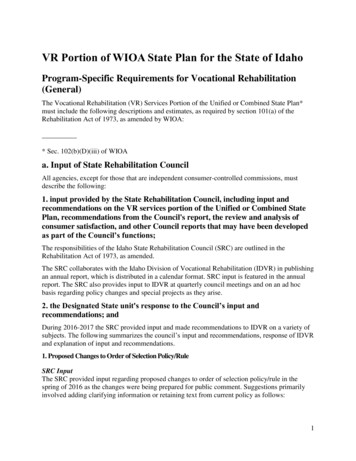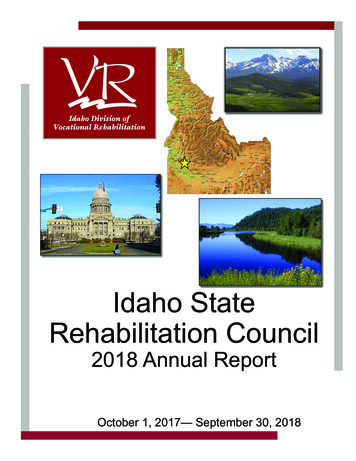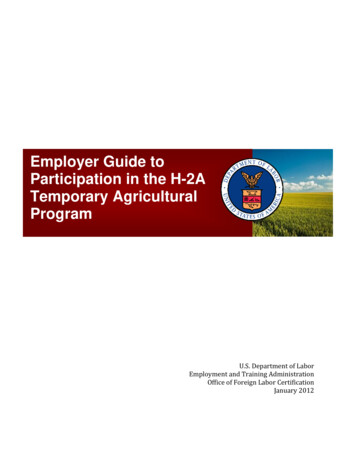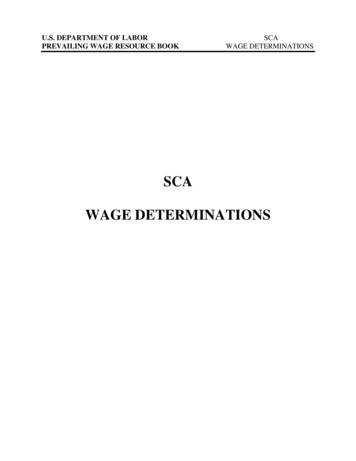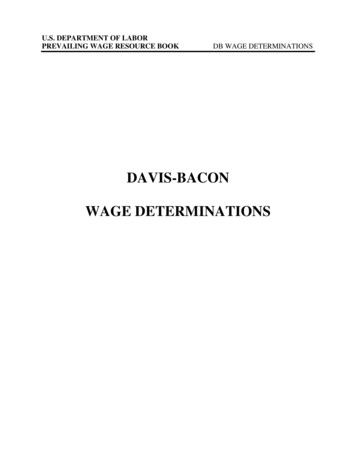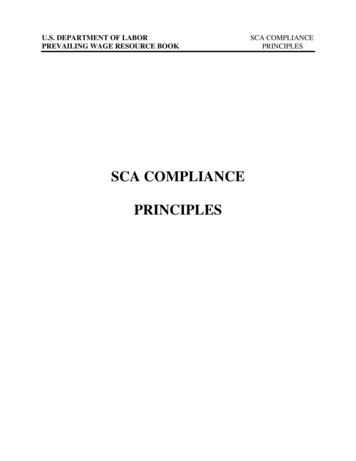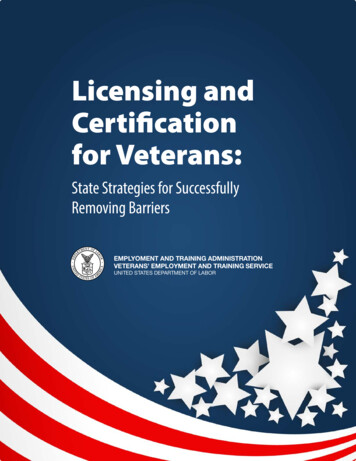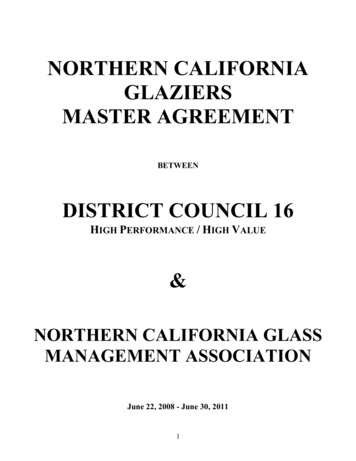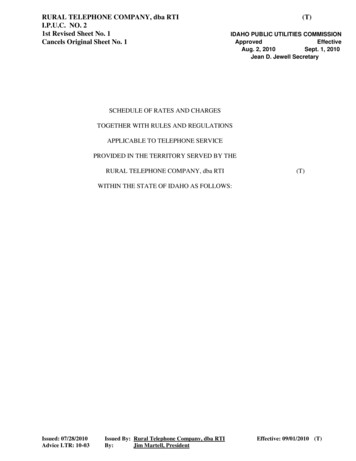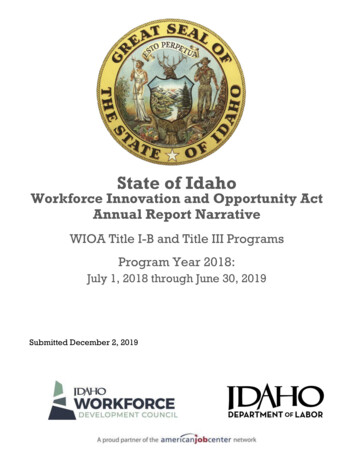
Transcription
State of IdahoWorkforce Innovation and Opportunity ActAnnual Report NarrativeWIOA Title I-B and Title III ProgramsProgram Year 2018:July 1, 2018 through June 30, 2019Submitted December 2, 2019
ContentsIntroduction . 2Goals for Idaho’s Workforce Development System. 2Workforce Development System Report. 4WIOA Program Updates. 41.WIOA Title I-B. 42.WIOA Title III Wagner-Peyser Employment Services. 83.Partner Programs within the State Workforce Agency . 94.Other WIOA Partners . 10Rapid Response. 10Sector Strategies . 10Career Pathways . 11Work-based Learning Opportunities, including Registered Apprenticeships. 11Business-Educator Exchange . 12Performance Accountability . 12Effectiveness in Serving Employers. 12Negotiated Performance and Outcomes . 13Table 1. Employment (Second Quarter after Exit). 13Table 2. Employment (Fourth Quarter after Exit). 14Table 3. Median Earnings (Second Quarter after Exit) . 14Table 4. Credential Attainment Rate . 14Customer Satisfaction . 15Data Validation Policy/Process . 16Evaluation Update. 16Waiver Update – To Allow the State Board to Act as the Local Board . 17APPENDICES . 20APPENDIX A – Data Validation Policy (Draft) . 20APPENDIX B - ID PY18 Statewide Performance Reports . 21Idaho PY18 WIOA Annual Report Narrative1
IntroductionThe State of Idaho has been working for several years on implementing the Workforce Innovation andOpportunity Act (WIOA) under a Combined State Plan to cover its statewide workforce developmentsystem. The original plan, its subsequent modifications and upcoming plans represent the collectiveplanning, resources, and vision of the state’s workforce board, the Workforce Development Council(WDC), and core partner programs as follows:A. WIOA Title I youth, adult, and dislocated worker programs, administered by the IdahoDepartment of Labor (IDOL);B. WIOA Title II Adult Education and Family Literacy program, administered by Idaho Career –Technical Education;C. WIOA Title III Wagner-Peyser Employment Service, also administered by the Idaho Departmentof Labor; andD. WIOA Title IV Vocational Rehabilitation programs, administered by Idaho Division of VocationalRehabilitation: Idaho Vocational Rehabilitation Program; and Idaho Commission for the Blind and Visually Impaired.In addition to Idaho’s core partner programs, other additional partner programs participating in Idaho’sCombined State Plan includes:E. Senior Community Service Employment Program, administered by the Idaho Commission onAging; andF. Jobs for Veterans State Grants, administered by the Idaho Department of Labor; andG. Trade Adjustment Assistance, administered by the Idaho Department of LaborH. Unemployment Insurance, administered by the Idaho Department of Labor.This WIOA Annual Report Narrative for the state describes its progress towards meeting its strategicvision and goals for Idaho’s workforce system. The primary focus is for those programs under Titles Iand III, as the other core programs under WIOA - Adult Education (Title II) and Vocational Rehabilitation(Title IV) - are not obligated to submit or include their specific program data for this report. Theappendices also contains the annual performance reports submitted to the U.S. Department of Labor’sEmployment and Training Administration for Title I-B Adult, Dislocated Worker and Youth programs; andTitle III Wagner-Peyser Employment Service.Goals for Idaho’s Workforce Development SystemPlan partners reviewed the broad goals and individual strategies for the State’s workforce systemestablished by the Workforce Development Council. For each goal, the Council identified severalstrategies that related specifically to the populations, services, policies, and priorities within the state.The strategies cited under each goal are a priority subset of the Council’s strategic plan and clarify howthe Councils goals relate to individuals with barriers to employment. Promote policies that align workforce, education, economic development, and entrepreneurshipto meet industry and employer’s workforce needs.o Leverage public and private resources (in order to provide greater levels of service to thosewith barriers to employment and in rural communities)Facilitate development of an Idaho workforce that is highly skilled and committed to continuouslearning.Idaho PY18 WIOA Annual Report Narrative2
Provide access to a full range of information and supports to prepare for work that leads toeconomic self-sufficiency for low-skilled and at-risk youth and adults, dislocated workersand others with barriers to employment.o Enhance opportunities for lifelong learning by expanding delivery options such as: i)stackable credentials, ii) compressed scheduling, iii) on-line and distance learning, iv)modularized curriculum and v) other alternative learning modalitieso Encourage the use of workplace flexibility options such as job sharing, job restructuring,part-time worker pools, flex-time and telecommuting to increase employment opportunitiesand retain quality workerso Promote employment practices and workplace environments that encourage a culture ofdiversity and inclusivenessSupport a comprehensive education and workforce delivery system.o Maintain a quality One-Stop Career System that connects employers and workers andfacilitates access to workforce services, education services and information.o Enhance coordination among workforce system partners and streamline services byeliminating duplication and ineffective or unnecessary practices.o Provide access to information, financial aid and other supportive services that allow allworkers to obtain education and training leading to employment.o Coordinate a system of work supports for low-income workers to help them stay employedand move toward economic self-sufficiency (e.g. food stamps, child care, and housing) andprovide safety nets to those who are in transition in the workforceo The state’s Combined Plan also contains four priority focus areas designed to improve Idaho’s workforcesystem under WIOA. These focus areas served as themes uniting the state’s workforce developmentpartners’ goals, strategies, and operational elements, as well as serving as guides for the structure of theState’s plan. Serving Rural CommunitiesThis is a significant challenge for Idaho’s workforce system as nearly every core and partnerprogram identified service to rural areas as difficult to achieve.Attracting, Training, and Retaining Quality StaffMany programs identified staffing issues as a barrier, which was primarily true for thoseprograms which provide direct services such as counseling and instruction.Career PathwaysIdaho’s in-demand and high-growth occupations are in industries such as government, retail,construction, and health care. However, these industries do not necessarily align with the TargetSector industries identified by the state, which include advanced manufacturing, technology,energy, and health care. This outlines a need for clear pathways that help move people fromcurrent in-demand occupations to occupations within the Target Sectors.Connecting YouthYouth ages 16-24 have a significantly higher chance of being unemployed than other age groups.The state must develop strategies to address the unique training and education needs of youthacross all of Idaho.Idaho PY18 WIOA Annual Report Narrative3
Workforce Development System ReportThe Workforce Development Council is the designated WIOA-compliant State Workforce DevelopmentBoard, and is specifically responsible for advising the Governor, Legislature and appropriate executiveagencies on matters related to developing and implementing a comprehensive workforce developmentstrategy for Idaho.The 36-member council brings together a well-integrated mix of business and industry, education, labor,community and government representatives to establish the vision and plan for Idaho’s workforcedevelopment system. The chair, vice chair and executive committee must be from the private sector.Appointed by the Governor, its overall membership includes: 17 positions representing industry;7 positions representing the workforce;9 positions representing government;One member from each chamber of the Idaho Legislature; andThe Governor or his designee.The Workforce Development Council performs the majority of its work through a committee structure.The full council meets quarterly; its committees meet monthly. The council empanels standing and adhoc committees, appointed by the chair when needed. Committee members may include individualsfrom the public who have special knowledge and qualifications to be of assistance to the council. Thecouncil currently has six standing committees: Executive CommitteeApprenticeship CommitteeWorkforce Development Policy CommitteeGrant Review CommitteeOne-Stop Committee andOutreach CommitteeWIOA Program UpdatesA robust economy has aided Idaho’s implementation of its goals under the WIOA Combined State Plan.Idaho’s unemployment rate for calendar year 2018 averaged 2.8%, a decrease from the previous year by.4%. The tight labor market has encouraged employers to work with the public workforce system,ensuring that staff know the workforce needs of employers in the state. Individuals who had previouslybeen discouraged or have significant barriers to employment are now re-entering the labor force. Thoseindividuals still seeking assistance from the public workforce system are those with the greatest barriersto employment - the hardest to serve.1. WIOA Title I-Ba.WIOA Title I-B Adult Program – Serving Disadvantaged AdultsThe WIOA Adult program provides employment and training assistance to adults who face significantbarriers to employment. Idaho’s program prioritizes individuals who receive public assistance,individuals living with low incomes, and those with basic skills deficiency. For each customer, theoverarching goal is employment or enhancement within his or her occupation.Idaho PY18 WIOA Annual Report Narrative4
Generally, Adult program customers work to increase their earnings, retain employment, and diversifytheir occupational skills. In PY 2018, the state program provided staff assistance to 13,896 individuals. Ofthose, WIOA career planners worked individually with 596 job seekers to provide more in-depth, oneon-one assistance. Idaho expended a total of 2,101,161 in providing these services during PY 2018.WIOA Adult Program Success StoriesMichelle - A 56 yr. old single female enrolled in the Adult program in 2017, Michelle was amidwife who had completed several years in a nursing program with 2 yrs. left to get herBachelor’s Degree. At the time of her enrollment, she was living in a camp trailer and receivingfood stamps. At the end of 2018 her daughter-in-law passed away from cancer and she took onmore responsibility helping her grandson cope and home-schooling him, too. With onesemester left, and strongly encouraged by her instructor to stay in school, she continued. Herefforts led to her induction into the Nursing Hall of Fame in February of 2019 along with an offerto join the Sigma Theta Tau Nursing Honor Society. After graduating with an overall GPA of 3.93in May 2019 and updating her resume, she was hired at the end of the month by BinghamMemorial Hospital, earning 24/hr. with full benefits. No longer on food stamps nor living in hercamper, Michelle took her NCLEX and received her license this summer.Seani enrolled in the WIOA Adult program in December 2018 as a homeless, disabled Veteran.Pregnant with two children, she was not working and living in a shelter that would allow heronly 2 more months additional stay. In addition, the pregnancy required her to have a C Section,meaning she would be unable to work for 6-8 weeks. The local DVOP and her WIOA careerplanner worked together to find the necessary resources that would assist Seani as sheprepared for work after the new baby arrived. Directing her to Idaho Housing and Finance, shequalified for a grant that allowed her to obtain an apartment for her family. In addition, theteam secured new baby items for baby once it was born, as well as having a local car dealershipprovide her a used van that would fit the entire family. To obtain new skillsets, the WIOA careerplanner placed her in a paid internship with the Idaho Heart Institute for a period of time beforethe baby was born. Since then, Seani had the baby and returned to work. She obtained daycarefor all her children and began working full time (32 hrs.) in the Medical Records unit at the IdahoHeart Institute earning 10.75/hr. and benefits, with a raise to 11.25/hr. after 90 days.b.WIOA Title 1-B Dislocated WorkerSimilar to the Adult Program, the Dislocated Worker program provides employment and trainingservices to individuals who are unemployed through no fault of their own and unlikely to return to workin their previous industry or occupation. For the past several years Idaho has experienced a very lowunemployment rate, which has caused structural changes in the state’s economy and intensified thedemand for labor. However, in instances where workers are impacted by layoffs or plant closures in thestate, many have received Rapid Response services at their place of employment or they visit a stateAmerican Job Center to seek unemployment insurance benefits.In continuous improvement efforts to enhance jobseeker services, Idaho’s Dislocated Worker programsought to maintain high levels of performance through collaboration with other programs, such as theTrade Adjustment Assistance Program and providing participant-based services utilizing labor marketinformation, and encouraging the enrollment of participants in employer-coordinated work-basedtraining, such as On-the-Job Training (OJT) and apprenticeships.Idaho PY18 WIOA Annual Report Narrative5
In Program Year 2018, the WIOA Title I-B Dislocated Worker program served 466 individuals, andexpended 1,871,865 in serving these customers. The Dislocated Worker program has experienced a49% decrease in overall funding from WIOA Program Year 2012, so staff and retraining resources arelimited to serve this population. Fortunately, the current economy is absorbing most unemployedworkers with minimal staff assistance. However, this population is still vulnerable to an economicdowntown where the structural changes affecting low-skill workers is exacerbated.DW Success Story - Wendie came in to the Mini-Cassia Idaho Department of Labor for an RESEAinterview after being laid off from her job as work-from-home Sales Rep. She sold packagedfood items to retail stores and scheduled deliveries of the merchandise all via phone or theInternet. Earning 21/hr. and benefits, she also supervised sales associates in the same line ofwork. She applied for various jobs, gaining interviews but no offers of employment. She lackedthe computer skills needed to compete in our labor market area and took a temporary, parttime, on-call retail position at Walmart for 9/hr. with no benefits.Discouraged and depressed, Wendie, being over 50, began to feel too old to be a viable labormarket competitor since the job search assistance and referrals provided by the local AJC wereto no avail. The solution pointed to updating her computer skills. Once she enrolled in anAdministrative Assistant training program, she began to regain her confidence. After completingthe program with a few bumps along the way, she applied for an upper management job withthe Walmart home office. Chosen for the position, she now travels throughout Washington,Oregon, Nevada, California, Montana, Wyoming and Utah to plan Walmart store remodels, andstays in the areas to see the projects through to completion utilizing skills she gained from herrecent training. Making 25/hr. with benefits, she can fly home for the weekend or have herhusband fly out to meet her at the job site. Now thriving, she loves her job and is very gratefulto the WIOA program for helping her get back to full-time work.c.WIOA Title I-B YouthIn keeping with Congressional intent for WIOA, Idaho’s Title I-B Youth program serves 100% out-ofschool youth. Idaho receives just slightly higher than the minimum allotment for WIOA Title I-B funds,and it intends to leverage its funding rather than divide the program’s priorities. The additionalrequirement for spending 20% of youth funding on work-based learning is also more appropriate forout-of-school youth. Additional State funds were provided to Youth program staff to leveragerelationships with MSFW outreach workers to find and serve eligible individuals within the MSFWcommunity who may not be reached or served through traditional means. (See MSFW section)To be eligible for WIOA out-of-school youth services, an individual must be between the ages of 16 to24, and not attending any school. In addition, other identified barriers must play a significant role inprohibiting the youth from successfully seeking or obtaining employment. WIOA helps to provide Idahoyouth the skills and knowledge to be successful members of the workforce.Idaho’s WIOA Youth Program served 627 youth in PY 2018: 23.3 percent of the youth served had adisability; 89.9 percent were from families receiving public assistance; 37 percent were system-involvedyouth (foster youth or juvenile o
Rehabilitation: Idaho Vocational Rehabilitation Program; and Idaho Commission for the Blind and Visually Impaired. In addition to Idaho’score partner programs, other additional partner programs participating in Idaho’s Combined State Plan includes: E. Senior Community Service Employment Program,
